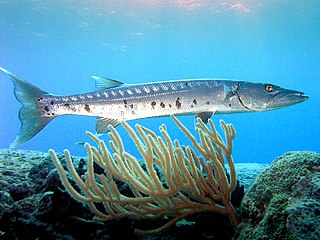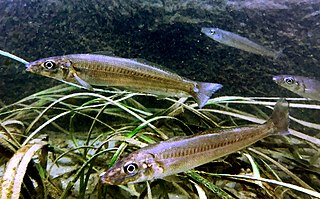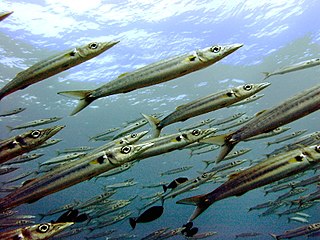
A barracuda is a large, predatory, ray-finned fish known for its fearsome appearance and ferocious behaviour. The barracuda is a saltwater fish of the genus Sphyraena, the only genus in the family Sphyraenidae, which was named by Constantine Samuel Rafinesque in 1815. It is found in tropical and subtropical oceans worldwide ranging from the eastern border of the Atlantic Ocean to the Red Sea, on its western border the Caribbean Sea, and in tropical areas of the Pacific Ocean. Barracudas reside near the top of the water and near coral reefs and sea grasses. Barracudas are targeted by sport-fishing enthusiasts.

Anago is the Japanese word for salt-water eels, normally referring to ma-anago. Ma-anago are used for a seafood dish in Japan. They are often simmered (sushi) or deep-fried (tempura), compared to unagi which are usually barbecued with a sauce (kabayaki). Anago is also slightly less rich and oily than unagi. Anago has a very soft texture and sweet taste.

The Australian barracuda, arrow barracuda, Australian sea pike, sea pike, snook, or shortfin barracuda, Sphyraena novaehollandiae, is a barracuda of the genus Sphyraena which occurs in the south-western Pacific Ocean.

The pickhandle barracuda is a species of barracuda found throughout the Indo-Pacific region. Its common name derives from the dark marks along its sides, which look like the thick ends of pickaxe handles. Sea anglers sometimes colloquially shorten the name to "pick". Other common names for the species include banded barracuda, yellowtail barracuda, and sea pike.

The Japanese angelshark is a species of angelshark, family Squatinidae, found in the northwestern Pacific Ocean off China, Japan, and Korea. It is a bottom-dwelling shark found in sandy habitats down to 300 m (980 ft) deep. This species has the flattened shape with wing-like pectoral and pelvic fins typical of its family, and grows to 1.5 m (4.9 ft) or more in length. Its two dorsal fins are placed behind the pelvic fins, and a row of large thorns occurs along its dorsal midline. Its upper surface is cryptically patterned, with numerous squarish dark spots on a brown background.

The yellowtail barracuda is one of the smaller species of barracuda of the family Sphyraenidae, which can be found in Indo-West Pacific oceans. It has also invaded the Mediterranean through the Suez Canal from the Red Sea, making it one of the Lessepsian migrants.

Sphyraena barracuda, commonly known as the great barracuda, is a species of barracuda: large, predatory ray-finned fish found in subtropical oceans around the world.

The Japanese whiting, also known as the Japanese sillago or Shiro-gisu, is a common species of coastal marine fish belonging to the smelt-whiting family, Sillaginidae. As suggested by its name, the Japanese whiting was first recorded from Japan in 1843, but has subsequently been found to extend to Korea, China and Taiwan.

Sphyraena argentea is a predatory species of marine barracuda fish of the family Sphyraenidae. They are found in the northeast Pacific Ocean, from Cabo San Lucas, Baja California Sur north to Washington State. However, they are not common north of Point Conception in Santa Barbara County, California, usually preferring warmer waters. They can reach a length of about 1.2 metres (3.9 ft) and a weight of about 6.8 kilograms (15 lb). This species of barracuda is a very popular sport fish in Southern California.

The blackfin barracuda, also known as the chevron barracuda, is known for its aggressive, predatory personality.

The sharpfin barracuda is a schooling species of barracuda that inhabits lagoons, bays and seaward reefs. It is nocturnally active. It grows to 80 cm (31 in) total length, although it is commonly somewhat smaller. The species is found across the Indo-Pacific from East Africa to the Hawaiian, Marquesan and Tuamoto islands, north to southern Japan.
Sphyraena sphyraena, also known as the European barracuda or Mediterranean barracuda, is a ray-finned predatory fish of the Mediterranean basin and the warmer waters of the Atlantic Ocean.

Sphyraena helleri, the Heller's barracuda, is a schooling species of barracuda in the family Sphyraenidae.

Sphyraena chrysotaenia, the yellowstripe barracuda, is a species of predatory, ray finned fish from the family Sphyraenidae which is found in the Indo-West Pacific region. It has entered the Mediterranean Sea from the Red Sea through the Suez Canal as a Lessepesian migrant and is now an important species in the fisheries of the eastern Mediterranean.

Brama japonica, the Pacific pomfret, is a species of marine ray-finned fish, a pomfret of the family Bramidae. B. japonica is closely related, and quite similar, to Brama brama, but can be distinguished by possessing a greater number of anal fin rays and a higher number of gill rakers.

Argentina sphyraena is a species of fish belonging to the family Argentinidae. Also known as the "stargazer", they inhabit the Eastern Atlantic, Mediterranean, and the Black Sea, and typically live between 10 and 100 meters in depth. The stargazers are sedentary fish that camouflage themselves in sand or mud in order to prey upon other animals. They are carnivorous, benthic predators, or "bottom dwelling", which means they eat small animal, and are very important to the food chain. These fish mainly feeds on polychaetes and crustaceans.

The bigeye barracuda is a species of the family Sphyraenidae, which can be found in the tropical Indo-West Pacific oceans, excluding Hawaii.

Sphyraena pinguis commonly known as the red barracuda, striped barracuda, brown barracuda, and more names, is a species of barracuda found in the Northwest Pacific, from Southeast Asia up through Japan. It is a pelagic species commonly found in large schools over muddy or sandy rock bottoms from southern Japan to Australia. They can commonly be found inhabiting large estuaries and coastal bays and juveniles can be found in shallow waters. Red Barracuda feed on smaller fish and can get up to 50 cm(20 in) long.
Sphyraena iburiensis is a relatively recently discovered species of barracuda in the genus Sphyraena only being formally described in 2005. Found in the Eastern Pacific most commonly between southern Japan and Taiwan. They can be differentiated from other species of Barracuda by the number and lay out of their scales and the presence of two distinctive longitudinal stripes. The lower of the two stripes are especially distinct stretching from the snout to the base of the caudal fin just below the lateral line. The species is also known for having a completely transparent membrane on the first dorsal fin.
Sphyraena lucasana is a species of barracuda found in the waters around southern Baja California and in the Gulf of California. Also known as the Lucas barracuda and the Cortez barracuda, this species can reach up to 76 cm in length. They are pelagic fish that hunt in open water and they themselves are often food for local fishing communities. This species also has a distinct protruding lower jaw that does not reach under the eye. Their color is silvery with around 20 on the upper side of the body with pale fins.
















